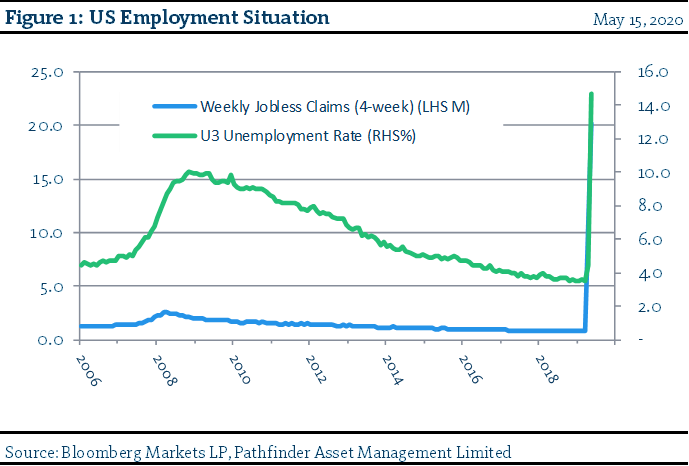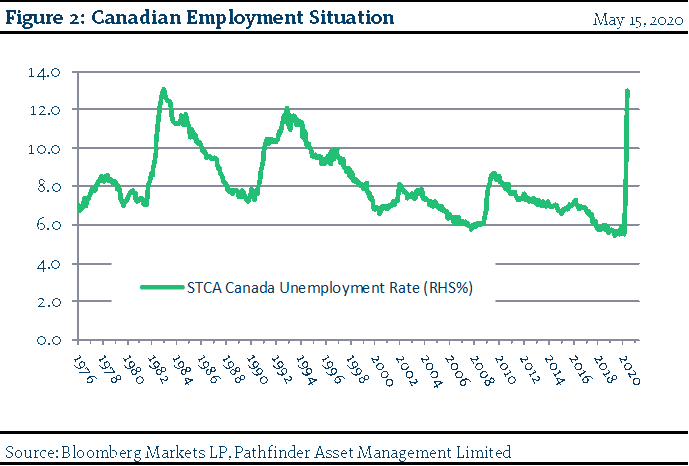US & Canadian Unemployment
Last week, in our Investment Outlook, we reported on the developing earnings season and the companies that reported their financial results every three months. Taking the time to write about that last Friday meant that we did not write about the historic US employment report released by the Bureau of Labor and Statistics. This week, we write about the North American job situation and our view of how that impacts our investment positioning. The actual level of unemployment is not yet at all-time highs in either country, but expected to get there over the coming summer months. What is historic is the pace at which we have reached these levels. A quick scan of the charts below indicates that they do not look like normal data sets … essentially going from normal to very abnormal instantaneously.
- Figure 1 presents employment data from the United States. The green line is the unemployment rate (%) and the blue line is Weekly Jobless Claims (millions). The chart presents data back to 2008 in order to compare the Great Financial Recession to the current situation. The blue line is particularly interesting. Weekly claims usually range between 200k-400k but have been 3-6 million a week since mid-March. The unemployment rate is currently 14.7% and we would have to go back to 1940 to get a level that high. The absolute high was 24.9% in the Great Depression.

- Figure 2 is unemployment data for Canada back though to 1976. Our current unemployment rate is 13.0% which is just under the previous high of 13.1% set in 1982. We found an old report from StatsCanada which indicated the previous high (19.3%) was in the 30’s.

- Both the Canadian and US data sets are troubling and real concern is how long it will stay like this
“This means that” we are at historically difficult times for our employment markets. We have been hearing more discussion in the media recently that economies will have a harder time bouncing back and the recovery will look less “V shaped”. The data seems to be playing out this way and this has been our thesis from the beginning. Our portfolios have been positioned for this and we hope to add great companies at great prices.
National Instrument 31-103 requires registered firms to disclose information that a reasonable investor would expect to know, including any material conflicts with the firm or its representatives. Doug Johnson and/or Pathfinder Asset Management Limited are an insider of companies periodically mentioned in this report. Please visit www.paml.ca for full disclosures.
*All returns are time weighted and net of investment management fees. Returns from the Pathfinder Partners’ Fund and Pathfinder Real Fund are presented based on the masters series of each fund. The Pathfinder North American Equity Portfolio and The Pathfinder North American Income Portfolio are live accounts. These are actual accounts owned by the Pathfinder Chairman (Equity) and client (High Income) which contain no legacy positions, cash flows or other Pathfinder investment mandates or products. Monthly inception dates for each fund and portfolio are as follows: Pathfinder North American Equity Portfolio (January 2011), Pathfinder North American High-Income Portfolio (October 2012) Pathfinder Partners’ Fund (April 2011), Pathfinder Real Fund (April, 2013), and Pathfinder International Fund (November 2014).
Pathfinder Asset Management Limited (PAML) and its affiliates may collectively beneficially own in excess of 10% of one or more classes of the issued and outstanding equity securities mentioned in this newsletter. This publication is intended only to convey information. It is not to be construed as an investment guide or as an offer or solicitation of an offer to buy or sell any of the securities mentioned in it. The author has taken all usual and reasonable precautions to determine that the information contained in this publication has been obtained from sources believed to be reliable and that the procedures used to summarize and analyze such information are based on approved practices and principles in the investment industry. However, the market forces underlying investment value are subject to sudden and dramatic changes and data availability varies from one moment to the next. Consequently, neither the author nor PAML can make any warranty as to the accuracy or completeness of information, analysis or views contained in this publication or their usefulness or suitability in any particular circumstance. You should not undertake any investment or portfolio assessment or other transaction on the basis of this publication, but should first consult your portfolio manager, who can assess all relevant particulars of any proposed investment or transaction. PAML and the author accept no liability of any kind whatsoever or any damages or losses incurred by you as a result of reliance upon or use of this publication.